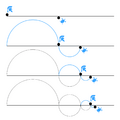Zeno's paradoxes facts for kids
Zeno's paradoxes are a collection of famous puzzles. They were created by a smart thinker named Zeno of Elea around 450 BC. For over 2,500 years, philosophers, physicists, and mathematicians have debated how to solve them.
Zeno made these puzzles to challenge ideas about how things move and change. He wanted to show that motion might be more complicated than it seems. Nine paradoxes are linked to Zeno. Two of the most famous ones are explained below. They all explore how space and time work.
Contents
Achilles and the Tortoise
This paradox tells a story about a race. The swift hero Achilles is racing a slow Tortoise. Achilles gives the tortoise a head start, for example, 100 metres.
Both start running at a steady speed. Achilles is very fast, and the tortoise is very slow. Achilles quickly runs the first 100 metres. This brings him to where the tortoise started. But while Achilles ran those 100 metres, the tortoise moved forward a little bit.
Now, Achilles must run that new, smaller distance. But again, while he runs that distance, the tortoise moves ahead a tiny bit more. This keeps happening. Every time Achilles reaches where the tortoise was, the tortoise has already moved a bit farther.
Because there are an infinite number of these small steps, Zeno argued Achilles can never actually catch the tortoise. He will always have a tiny distance left to cover.
The Dichotomy Paradox
Imagine you want to walk from point A to point B. To get there, you first have to walk halfway. Once you've done that, you still have half the distance left.
Now, you must walk half of that remaining distance. You've covered three-quarters of the total. But you still have a quarter left. You keep going, always walking half of what's left.
This means there will always be a small distance remaining. You would never truly reach your goal. It's like adding numbers in a series: 1/2 + 1/4 + 1/8 + 1/16 + and so on. Zeno suggested that moving from one point to another seems impossible.
Proposed Solutions
Most people would agree that Achilles would win the race. So, what is wrong with Zeno's clever arguments?
When you add the numbers in a series like 1/2 + 1/4 + 1/8 + 1/16 + ..., you might notice something. The total sum gets closer and closer to 1. It will never go over 1.
Aristotle, a famous ancient Greek thinker, studied Zeno's paradoxes. He pointed out that as the distances get smaller, the time it takes to travel each distance also gets much, much smaller.
Before 212 BC, a smart mathematician named Archimedes found a way to solve this. He developed a method to find a final answer for adding up an infinite number of terms that get smaller and smaller. Modern calculus uses more advanced methods to do the same thing.
Some mathematicians, like Carl Boyer, believe Zeno's paradoxes are just math problems. They think modern calculus provides the perfect mathematical solution.
However, Zeno's questions can still be tricky if you think about doing each tiny step one at a time. This is sometimes called a 'supertask'. Calculus doesn't actually add numbers one by one. Instead, it finds the limit. This is the value that the sum is getting closer and closer to.
Images for kids
See also
 In Spanish: Paradojas de Zenón para niños
In Spanish: Paradojas de Zenón para niños




